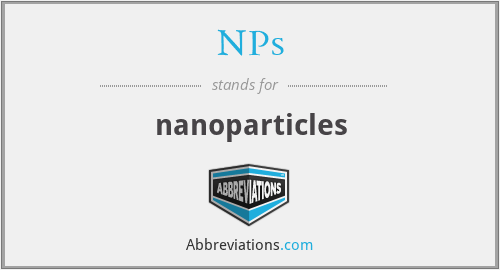What does NPs mean in Physics?
This page is about the meanings of the acronym/abbreviation/shorthand NPs in the Academic & Science field in general and in the Physics terminology in particular.
nanoparticles
Submitted by agnm on May 13, 2013
Translation
Find a translation for nanoparticles in other languages:
Select another language:
- - Select -
- 简体中文 (Chinese - Simplified)
- 繁體中文 (Chinese - Traditional)
- Español (Spanish)
- Esperanto (Esperanto)
- 日本語 (Japanese)
- Português (Portuguese)
- Deutsch (German)
- العربية (Arabic)
- Français (French)
- Русский (Russian)
- ಕನ್ನಡ (Kannada)
- 한국어 (Korean)
- עברית (Hebrew)
- Gaeilge (Irish)
- Українська (Ukrainian)
- اردو (Urdu)
- Magyar (Hungarian)
- मानक हिन्दी (Hindi)
- Indonesia (Indonesian)
- Italiano (Italian)
- தமிழ் (Tamil)
- Türkçe (Turkish)
- తెలుగు (Telugu)
- ภาษาไทย (Thai)
- Tiếng Việt (Vietnamese)
- Čeština (Czech)
- Polski (Polish)
- Bahasa Indonesia (Indonesian)
- Românește (Romanian)
- Nederlands (Dutch)
- Ελληνικά (Greek)
- Latinum (Latin)
- Svenska (Swedish)
- Dansk (Danish)
- Suomi (Finnish)
- فارسی (Persian)
- ייִדיש (Yiddish)
- հայերեն (Armenian)
- Norsk (Norwegian)
- English (English)
Definition
What does NPs mean?
- nanoparticles
- A nanoparticle or ultrafine particle is usually defined as a particle of matter that is between 1 and 100 nanometres (nm) in diameter. The term is sometimes used for larger particles, up to 500 nm, or fibers and tubes that are less than 100 nm in only two directions. At the lowest range, metal particles smaller than 1 nm are usually called atom clusters instead. Nanoparticles are usually distinguished from microparticles (1-1000 µm), "fine particles" (sized between 100 and 2500 nm), and "coarse particles" (ranging from 2500 to 10,000 nm), because their smaller size drives very different physical or chemical properties, like colloidal properties and ultrafast optical effects or electric properties. Being more subject to the brownian motion, they usually do not sediment, like colloidal particles that conversely are usually understood to range from 1 to 1000 nm. Being much smaller than the wavelengths of visible light (400-700 nm), nanoparticles cannot be seen with ordinary optical microscopes, requiring the use of electron microscopes or microscopes with laser. For the same reason, dispersions of nanoparticles in transparent media can be transparent, whereas suspensions of larger particles usually scatter some or all visible light incident on them. Nanoparticles also easily pass through common filters, such as common ceramic candles, so that separation from liquids requires special nanofiltration techniques. The properties of nanoparticles often differ markedly from those of larger particles of the same substance. Since the typical diameter of an atom is between 0.15 and 0.6 nm, a large fraction of the nanoparticle's material lies within a few atomic diameters of its surface. Therefore, the properties of that surface layer may dominate over those of the bulk material. This effect is particularly strong for nanoparticles dispersed in a medium of different composition since the interactions between the two materials at their interface also becomes significant. Nanoparticles occur widely in nature and are objects of study in many sciences such as chemistry, physics, geology and biology. Being at the transition between bulk materials and atomic or molecular structures, they often exhibit phenomena that are not observed at either scale. They are an important component of atmospheric pollution, and key ingredients in many industrialized products such as paints, plastics, metals, ceramics, and magnetic products. The production of nanoparticles with specific properties is a branch of nanotechnology. In general, the small size of nanoparticles leads to a lower concentration of point defects compared to their bulk counterparts, but they do support a variety of dislocations that can be visualized using high-resolution electron microscopes. However, nanoparticles exhibit different dislocation mechanics, which, together with their unique surface structures, results in mechanical properties that are different from the bulk material.Non-spherical nanonparticles (e.g., prisms, cubes, rods etc.) exhibit shape-dependent and size-dependent (both chemical and physical) properties (anisotropy). Non-spherical nanoparticles of gold (Au), silver (Ag), and platinum (Pt) due to their fascinating optical properties are finding diverse applications. Non-spherical geometries of nanoprisms give rise to high effective cross-sections and deeper colors of the colloidal solutions. The possibility of shifting the resonance wavelengths by tuning the particle geometry allows using them in the fields of molecular labeling, biomolecular assays, trace metal detection, or nanotechnical applications. Anisotropic nanoparticles display a specific absorption behavior and stochastic particle orientation under unpolarized light, showing a distinct resonance mode for each excitable axis.
Popularity rank by frequency of use
How popular is NPs among other acronyms?
NPs#1#1575#12977
Embed
Citation
Use the citation below to add this abbreviation to your bibliography:
Style:MLAChicagoAPA
"NPs." Abbreviations.com. STANDS4 LLC, 2024. Web. 1 May 2024. <https://www.abbreviations.com/term/1437857>.



Discuss this NPs abbreviation with the community:
Report Comment
We're doing our best to make sure our content is useful, accurate and safe.
If by any chance you spot an inappropriate comment while navigating through our website please use this form to let us know, and we'll take care of it shortly.
Attachment
You need to be logged in to favorite.
Log In